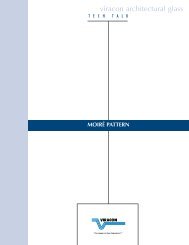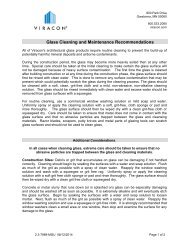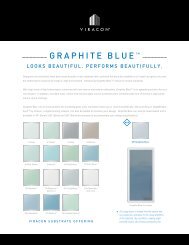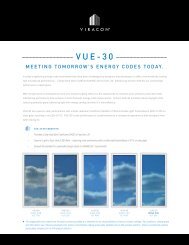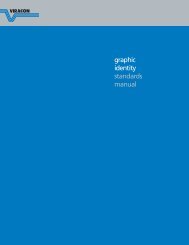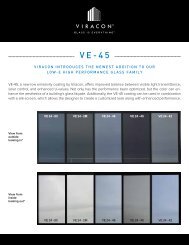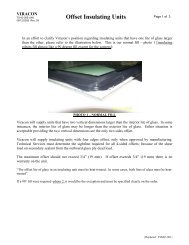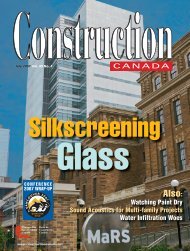2 0 1 3 P R O D U C T G U I D E VIRACON PRODUCT GUIDE 2013 ...
2 0 1 3 P R O D U C T G U I D E VIRACON PRODUCT GUIDE 2013 ...
2 0 1 3 P R O D U C T G U I D E VIRACON PRODUCT GUIDE 2013 ...
You also want an ePaper? Increase the reach of your titles
YUMPU automatically turns print PDFs into web optimized ePapers that Google loves.
GLOSSARY<br />
Lite: Another term for a pane of glass. Sometimes spelled "light" in industry literature.<br />
Low-E: An abbreviation for Low Emissivity coatings. They are applied to glass to reflect invisible long-wave infrared or<br />
heat. They reduce heat gain or loss in a building by redirecting the heat. In addition they typically provide greater light<br />
transmission low reflection and reduce heat transfer.<br />
Low iron: Low iron glass is a type of float glass manufactured with less iron than standard clear glass. With this reduction in<br />
iron content the greenish tint is reduced. UltraWhite, Starphire and Optiwhite are low iron glass substrates.<br />
Lucor: A powder used to separate lites of glass to prevent damage from scratching or rubbing.<br />
Mock-Up: A full size sample or model of a unit normally used to judge appearance and performance.<br />
Monolithic: Refers to a single lite of glass as a finished product.<br />
Mullion: A horizontal or vertical member that supports and holds such items as panels, glass, sash or sections of a curtain wall.<br />
Negative Air: Refers to an insulating unit wherein the two lites of glass are closer together in the center of the unit than they<br />
are at the edge. This gives the unit the appearance of being "bowed in".<br />
Nickel Sulfide: An inclusion in float glass that can cause spontaneous breakage in fully tempered glass.<br />
Offset: Glass unit wherein the two glass ply edges are intentionally not aligned.<br />
oitc Rating: Outside-Inside Transmission Class Rating used to classify acoustic performance of glazing in exterior<br />
applications.<br />
Pattern Glass: Glass with textured surface to emit light but restrict vision.<br />
Polished Edge: A special fabrication done to the edge of a piece of glass. Makes the edge smooth and gives it an extremely<br />
shiny or polished appearance.<br />
Polyisobutylene (PIB): The primary seal of an insulating unit and the key component in restricting moisture vapor transmission.<br />
Polyurethane: Also commonly called urethane. Used by some insulating fabricators for a secondary sealant. It is also an<br />
interlayer used in polycarbonate security products.<br />
Polyvinyl Butyral (PVB): The plastic or vinyl used in the makeup of a laminated unit the vinyl is what holds that unit together.<br />
Positive Air: The opposite of negative air. In an insulating unit where the center of the unit is farther apart than around the air<br />
spacer these units have a bowed out appearance.<br />
Pyrolytic Deposition: A process of applying a thin metallic coating to the surface of flat glass during the float glass<br />
manufacturing process.<br />
R-Value: Thermal resistance of a glazing system expressed ft2/hr/°F/BTU (m2/W/°C). The r-value is the reciprocal of the<br />
U-value. The higher the R-value, the less heat is transmitted through the glazing material.<br />
rat Equation: The RAT equation accounts for 100 percent of solar energy which is equal to the sum of solar reflectance<br />
absorption and transmittance. For example with a single pane of 1/8” (3mm) clear glass 83 percent of solar energy is<br />
transmitted 8 percent is reflected and 9 percent is absorbed by the glass. Of the solar energy absorbed portions are emitted<br />
back towards the exterior and towards the building interior.<br />
Reflective Glass: See Solar Reflective Coatings<br />
Relative Heat Gain (RHG): The amount of heat gained through glass taking into consideration the effects U-value and shading<br />
coefficient. The English System relative heat gain is calculated as: RHG = (Summer U-value x 14°F) + (Shading Coefficient x<br />
200). The Metric System is calculated as: RHG = (Summer U-value x 7.8°C) + (Shading Coefficient x 630). The lower the RHG<br />
the more the glass product restricts heat gain.<br />
<strong>VIRACON</strong> // RESOURCES 131



